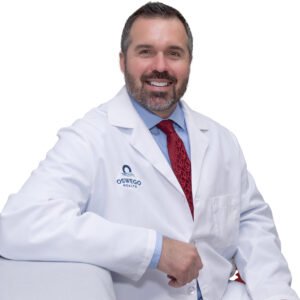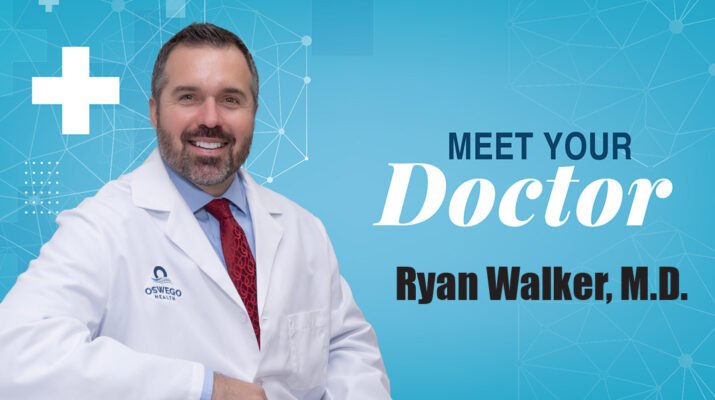General surgeon discusses the growing use of robotic surgery at Oswego Hospital
By Chris Motola
 Q: I’ve been doing this for a while, so I remember when the DaVinci robot first debuted in the major urban hospitals in Upstate New York. So seeing it make its way to a smaller rural hospital like Oswego years later is incredible. How many physicians are using it there?
Q: I’ve been doing this for a while, so I remember when the DaVinci robot first debuted in the major urban hospitals in Upstate New York. So seeing it make its way to a smaller rural hospital like Oswego years later is incredible. How many physicians are using it there?
A: There are seven of us now. We just got our robot in July 2024 and we started with three experienced surgeons; a bunch of us have worked at other places that had different versions of the robots. So it was myself, a general surgeon and two bariatric surgeons for the first few months. We’ve since added other two general surgeons, a third bariatric surgeon and a urologist. So now there are seven of us, five days a week, doing as many cases as we can do. We’ve opened access to the robot to urgent and emergent cases, so there’s now technically 24/7 access to the robot, if needed.
Q: What kinds of procedures are you using it for?
A: For general surgeons a lot of what we do on the robot would be gall bladders and then hernias of every variety. Those are our main cases. Our appendectomies we’re still mostly doing laparoscopically. Some we’ll do robotically if it’s appropriate. A lesser number of colon cases we’ll do with the robot as well.
Q: What advantages does the robot offer over laparoscopy?
A: We look at it three different ways. The instruments of the robot versus laparoscopic. The buzzword is the robotic instruments are “wristed,” meaning that they have a wrist at the tip of the instrument. The robotic instruments have a wider range of motion than the human wrist. It can move 90 degrees in every cardinal plane compared to 70 in one direction and 20 to 40 in others with the human wrist and it’s applied at the very tip of the instrument where it matters most. With laparoscopic instruments they’re just straight; there’s no wrist at all, so you’re very limited in your movements. That degree of freedom makes a big difference and then add in precision. If you’ve ever looked in the console, it’s a very magnified view. These instruments are very tiny, maybe a centimeter and you’re able to see millimeter movements. So you have very precise control of what you’re doing. It’s an incredible visualization and it’s 3D. There are two teeny tiny cameras applied at the tip of the scope to create true 3D images. The advantage, I think, is that the surgeon can control everything from the console. With laparoscopic surgery I might have two different assistants controlling the camera. Going back to what you said about smaller hospitals: we don’t necessarily have as much help available; being able to do this all from the console is a big deal.
Q: What’s the learning curve like?
A: It’s interesting. Everyone has the idea that these systems are incredibly difficult to learn. It gets compared to laparoscopic surgery a lot, but if you really look at robotic surgery it’s actually more analogous to open surgery which is what most surgeons are comfortable with. Robotic surgery mimics open surgery in a lot of ways, so that comes through in the learning curve. Hernias are some of our most common operations and we learn to do them openly, laparoscopically and robotically. Taking groin hernias as an example, the learning curve for laparoscopic surgery is around 50 cases for the easier cases and around 250 for the harder ones. When we switch from laparoscopic to robotic, the learning curve is more like around 10 cases. The speed at which you can become proficient and familiar with the platform is very fast.
Q: Do you think the robot will allow rural hospitals to take on more complex cases that would otherwise be referred to a major hospital?
A: Our focus in this first year is adoption, getting everyone trained and up-to-speed and ensure quality. We want to be sure we can at minimum replicate the results we were getting from laparoscopic surgery. So we’re starting with the cases we’re comfortable. Once we’re all up to speed the next step would be as you stated; we could take on more complex cases and get better outcomes. So we can start expanding our scope of practice to more complex hernia repairs. We could start doing more colon surgeries and more foregut procedures. So you start with your bread and butter and,, as you become more comfortable, expand your services. That’s huge for a community hospital. It’s a win for everybody.
Q: From the patient’s perspective, what are the advantages of undergoing a procedure with the robot?
A: We try to stick with what the literature supports, so they’re getting smaller incisions which usually means less pain overall and better cosmetic results compared to open surgery. We tend to see lower pain scores relative to laparoscopic surgery. Slightly lower blood loss. We want to provide the best repair possible and reduce the chance of recurrence and get back to the things they enjoy or need to do. We know we do a better job of that robotically, certainly compared to open surgery but also compared to laparoscopic.
Lifelines
Name: Ryan Walker, M.D.
Position: Specialty care physician lead at Oswego Health; chairman of Oswego Health’s robotics committee
Career: Before joining Oswego Health, practiced in the Albany area at both St. Peter’s Health Partners and St. Mary’s Healthcare
Hometown: Wappingers Falls (Dutchess County)
Education: Ithaca College (undergraduate), American University of the Caribbean, post-graduate training along with his chief residency at York Hospital in Pennsylvania. DaVinci-certified robotic surgeon
Affiliations: Oswego Health
Organizations: American College of Surgeons; Society of Laparoscopic and Endoscopic Surgeons
Family: Wife, two cats
Hobbies: Boating, fishing, skiing

